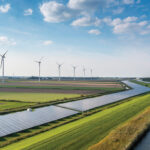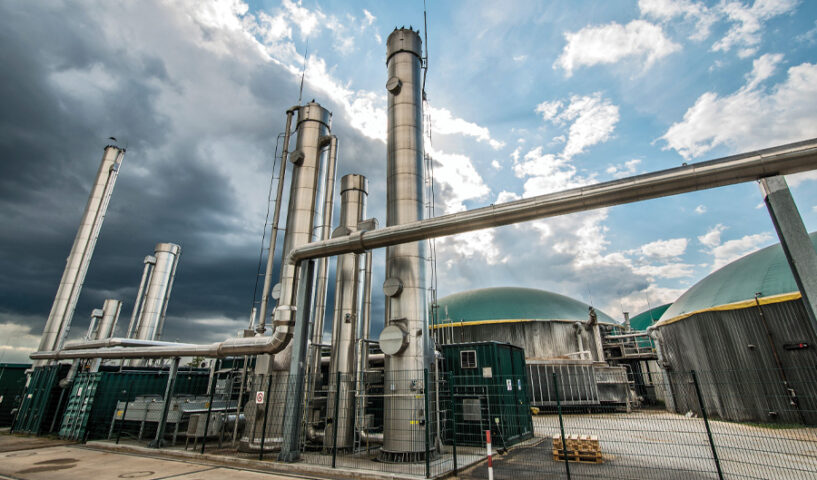
Smart energy decisions need urgent action
9th October 2023
The economic impact of climate change
9th October 2023Renewable gas: Ireland’s energy future

Jerry Murphy, Professor of Civil Engineering at University College Cork and Director of MaREI, discusses the role of renewable gas in decarbonising Ireland’s energy system.
Murphy breaks down the science behind the energy transition, and how, in a sense, hydrogen is already being used for our energy systems. “When I think of the term ‘gas’, I always think of the hydrogen molecule itself. When Germany gets natural gas [methane] (CH4) from Russia, it is the hydrogen molecules within the methane that those in the energy sector are interested in. From natural gas, we can make ammonia (NH3), and methanol (CH3OH); green hydrogen molecules will allow us to produce green ammonia, green methanol, and also green steel.”
A civil engineer by trade, Murphy outlines his excitement for the scale of infrastructure being developed under the Dublin Declaration. “Offshore wind is very exciting. My graduates will be very heavily employed for the next 20 years putting these massive devices into the ocean. We are talking about high levels of development of non-synchronous penetration which will mean us having very high levels of intermittent renewable electricity in the system.”
Murphy outlines his ambition for a potential long-term production of hydrogen in Ireland, arguing that the opportunity for the economy of Ireland must be maximised, rather than the future hydrogen surplus simply serving the energy needs of other countries.
“It is expected that Ireland will produce and distribute hydrogen molecules to other European countries so that European countries can use that hydrogen to produce ammonia and methanol and steel and have big industry.
“I do not want to see our electricity or hydrogen just being exported at a cheap price to Europe. I want us to use this to energy to create jobs and prosperity at home. We must develop the offshore electricity infrastructure, and electrify energy in Ireland as much as possible; energy beyond our needs should be converted to a form or product that, if exported, optimises value for money in Ireland.”
Caution against ‘cheap hydrogen’
In a paper carried out by MaREI, Hydrogen from offshore wind: Investor perspective on the profitability of a hybrid system including for curtailment, Murphy’s team examine the expected surplus in hydrogen production Ireland will have by 2035 and grapple with the question as to whether Ireland should produce electricity or hydrogen. “We have this idea of a hybrid system where if the sale value of electricity from a wind farm drops to €0.04/kWh, the developer produces hydrogen instead of selling electricity until the value of electricity on the wholesale market increases; hydrogen from electricity at €0.04/kWh will cost around €3.70/kg, which is around €0.11/kWh of hydrogen.”
Murphy continues: “Electrolysers are around 70 per cent efficient, so when we hear people talk about cheap hydrogen of say €0.11/kg, which is equivalent to €0.03/kWh of hydrogen, we worry. Because the electrolyser is 70 per cent efficient, the maximum price that the electricity would get for this cheap hydrogen would be €0.02/kWh, if we assume electrolysers are free – which they are not. We need reality when we talk about the price of hydrogen: the guy producing the electricity needs to make money, and the person producing the hydrogen needs to make money.”
How to use a hydrogen surplus
Whilst expressing his scepticism that hydrogen can be used to cover the whole energy system, Murphy believes that “hydrogen as a transport fuel works well”. “If we have hydrogen at €0.11/kWh, that is equivalent to €1.10 per litre of diesel. If you put into a fuel cell, which is more efficient, it has a lot of economic merit; hydrogen is ideally suited to long distance heavy transport and may be more beneficial than a battery powered truck for distances in excess of 450km.”
On developing the infrastructure to produce hydrogen in line with the Government’s Climate Action Plan commitments, Murphy outlines the scale of the challenge of constructing approximately 467 15MW wind turbines necessary to meet the 5GW electricity and 2GW hydrogen target for offshore wind by 2030. “The scale of this is enormous when we consider a 15MW turbine can be 320 metres high, similar in scale to the Eiffel Tower,” he says.
The UCC professor also outlines the choices between having electrolysers on land and bringing electricity ashore in a high-voltage direct current (HVDC) cable. “HVDC cables are expensive, have a limited GW capacity and there are bottlenecks in supply leading to delays in development time. The alternative is positioning electrolysers in the ocean, and use a relatively straightforward hydrogen pipe which can transport a lot more energy to shore.
“For hydrogen production in the ocean, you need a battery, a de-salination unit – because you need clean water to put into your electrolyser – and an electrolyser all floating on a platform with the turbine in the ocean. These are essentially massive factories floating on the ocean.”
Other areas for development
Murphy says that his work is all about ‘Power-to-X’, a formula on how best to use electricity and energy surpluses. “When ‘x’ is equal to ‘1’, it is hydrogen (H2); when ‘x’ equals ‘2’, it is methane (CH4); and when ‘x’ is equal to ‘3’, it is methanol (CH3OH),” he explains.
“We are going along pathways on which the renewable hydrogen molecule is extremely important. We can produce green methanol from renewable methane – worldwide production of methanol is 110 million tonnes and additional to this, it is going to be the shipping fuel of the future.”
Explaining that with hydrogen production Ireland could produce ammonia (NH3) fertiliser, Murphy states: “There are 150 million tonnes of ammonia produced globally. If we want to have decarbonised agriculture, we have a fantastic opportunity with our expected offshore wind production in 2035. Green ammonia can be made with hydrogen (from offshore wind) and nitrogen from the atmosphere. We have a route to produce green fertiliser in significant quantities.”
He also adds how this course of action could have the best means of promoting climate action policies to the agricultural sector.
On the current target for anaerobic digestion of 5.7 TWh, which Murphy says is “equivalent to 600MW anaerobic digesters putting methane into the gas grid”, the MaREI Director argues: “If you put biomethane into the gas grid you have CO2 left behind which could be the biogenic source of carbon to allow conversion of hydrogen (H2) to methanol (CH3OH). We can have a renewable hydrocarbon industry through combining of anaerobic digestion with renewable hydrogen.”
Although he states that he has “struggled with the slow pace” of the anaerobic digestion industry in Ireland, Murphy believes that “anaerobic digestion is very important for organic farms”.
“If you want an organic farm but you have no fertiliser being brought in, your yields drop, but if you can digest all your dungs and slurries and make a biofertiliser, your yields go back up.”
“Electrolysers are around 70 per cent efficient, so when we hear of people talk about cheap hydrogen of say €1/kg, which is equivalent to €0.03/kWh of hydrogen, we worry.”
German and Danish examples
With the scope for development of green gas in Ireland, Murphy points to successful examples with anaerobic digestion in Denmark and Power-to-X in Germany.
In the German town of Wertle, there is a 2MW digestor treating the local area’s food waste. Murphy tells of how biomethane goes directly into the region’s gas grid and CO2 is left behind as a by-product. The facility also has a 6MW electrolyser which produces hydrogen. Murphy tells that “with this facility, you would have offshore wind, from off the north coast of Germany and because the electrical infrastructure required to bring the electricity to the industrial heart land in the south is limited, they have an electrolyser”.
Murphy further explains the science behind the Power-to-X process which operates through the Sabatier Equation, where four moles of hydrogen (H2) and one mole of carbon dioxide (CO2) makes one mole of methane. This, he says, is “Power-to-X when ‘x’ is equal to 2”. “You are converting the hydrogen to methane and the reason for that is that there is a gas grid there already.”
The catalytic Sabatier process in Wertle operates at 420oC. Murphy explains how an alternative biological process can operate at 55oC and be more suitable for development at biogas facilities. “Microbes eat hydrogen and carbon dioxide and make methane. We found a biological way to convert hydrogen to methane. We just fed our biogas reactors with hydrogen and carbon dioxide. There are always challenges, hydrogen is very slow to go into solution, but we modelled and then built the system, and we are operating at over 95 per cent efficiency.”
Murphy further elaborates on more expansive facilities: “The oxygen (O2) from an electrolyser could go to a cement factory which gives you lean cement. You can then capture the carbon dioxide (CO2) from the cement factory, to react with the hydrogen from an electrolyser to make methanol. Doing this, you have now reduced the CO2 output from cement, you are using electricity that may otherwise be dispatched down, you are making methanol which can be a precursor to sustainable aviation fuel.”
In Denmark, the Danish Government decided in 2010 that there would be no more spreading slurry on the land by 2030. As of 2020, they are halfway there. This, Murphy explains “is to overcome eutrophication and pollution of wells”.
Currently, 35 per cent of Denmark’s energy supply comes from green gas in the form of biomethane. Murphy explains: “The Danes are proposing to use electrolysers and biological methanation systems which will upgrade their biogas to pure methane and would also double their overall gas production as the CO2 in the biogas is converted to biomethane. The Danes are saying that they will have 100 per cent green gas in their gas grid by 2035.”
Concluding, Murphy emphasises that we must use as many technologies as possible so that: “By 2035, we will have met our renewable energy production targets and will be able to power ourselves.”

